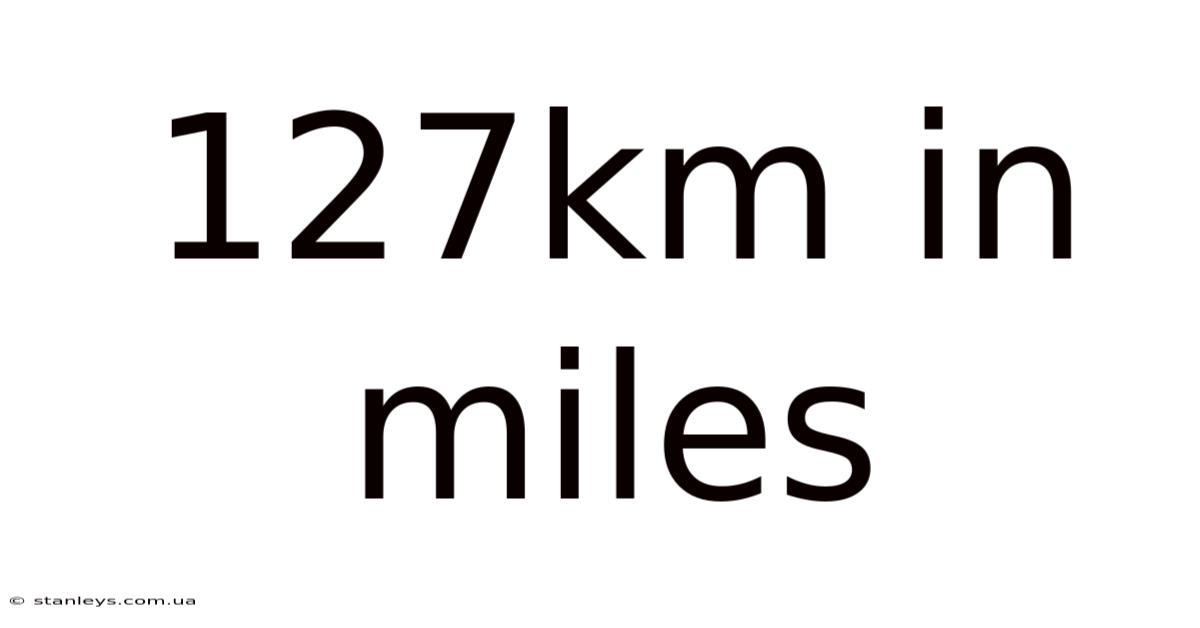127km In Miles
stanleys
Sep 17, 2025 · 4 min read

Table of Contents
127km in Miles: A Comprehensive Guide to Metric-Imperial Conversion
Converting kilometers to miles, or vice versa, is a common task for anyone who travels internationally or works with global data. This comprehensive guide will delve into the conversion of 127 kilometers to miles, explaining the process, providing the accurate answer, exploring the historical context behind these units of measurement, and addressing frequently asked questions. We'll also look at practical applications of this conversion and provide tips for similar conversions in the future. Understanding this seemingly simple conversion opens a window into the fascinating world of unit systems and their practical implications.
Understanding Kilometers and Miles: A Brief History
Before we dive into the calculation, let's briefly explore the history and context of kilometers and miles. Both are units of distance, but they originate from different systems.
-
Kilometers (km): Part of the metric system, kilometers are based on the meter, which was originally defined as one ten-millionth of the distance from the North Pole to the equator along a meridian passing through Paris. The metric system is a decimal system, making conversions within the system relatively straightforward. One kilometer equals 1000 meters. The metric system is favored globally for its simplicity and ease of use.
-
Miles (mi): Part of the imperial system, miles have a more complex and less consistent history. The Roman mile, mille passus, was approximately 1480 meters. The modern mile's length varies slightly depending on the country and specific definition (e.g., statute mile, nautical mile). The imperial system, while still used in some countries, is less standardized and often presents challenges in conversions. For our purposes, we will use the standard statute mile.
Calculating 127km in Miles: The Conversion Process
The conversion factor between kilometers and miles is approximately 0.621371. This means that one kilometer is equal to 0.621371 miles. To convert 127 kilometers to miles, we simply multiply the number of kilometers by the conversion factor:
127 km * 0.621371 mi/km ≈ 78.9 miles
Therefore, 127 kilometers is approximately equal to 78.9 miles. It's important to note that this is an approximation due to the nature of the conversion factor. The exact number will vary slightly depending on the precision used in the conversion factor.
Practical Applications and Real-World Examples
The conversion of kilometers to miles has numerous real-world applications:
-
Travel Planning: Whether you're planning a road trip, a flight, or a hike, converting distances ensures you have a clear understanding of the journey's length. Knowing that a 127km drive translates to roughly 79 miles can significantly aid in trip planning and estimations of travel time.
-
Mapping and Navigation: Many GPS devices and mapping applications allow you to switch between kilometers and miles, but understanding the conversion allows for easier interpretation of distances displayed.
-
Sports and Fitness: Runners, cyclists, and other athletes often use both metric and imperial units. Converting distances is essential for comparing performance across different races and events. A 127km cycling race is a significant undertaking, equivalent to almost 80 miles.
-
Logistics and Transportation: In international shipping and transportation, converting units is crucial for accurate calculations of distances, fuel consumption, and delivery times.
-
Scientific Research: Data analysis often involves converting between units to ensure consistency and comparability across different datasets. For example, in geographical studies, distances may need to be converted between kilometers and miles.
Beyond the Basic Conversion: Exploring Different Conversion Methods
While multiplying by the conversion factor is the most straightforward method, there are alternative approaches:
-
Using an online converter: Numerous online tools are available that instantly convert kilometers to miles and vice versa. These tools are convenient but understanding the underlying calculation is still beneficial.
-
Using a calculator: A simple calculator can perform the multiplication. This offers more control and allows for greater precision.
Frequently Asked Questions (FAQ)
-
What is the exact conversion factor from kilometers to miles? The exact conversion factor is approximately 0.621371, but it can vary slightly depending on the level of precision.
-
Why is the conversion not a whole number? The conversion factor is not a whole number because kilometers and miles are based on different systems of measurement with different historical origins.
-
How can I convert miles back to kilometers? To convert miles back to kilometers, use the inverse conversion factor: 1 mile ≈ 1.60934 kilometers. So, to convert 78.9 miles back to kilometers, multiply 78.9 by 1.60934.
-
Are there any other units of distance I should know? Yes, other units of distance include nautical miles (used in maritime and aviation), yards, feet, and inches (all part of the imperial system).
Conclusion: Mastering Metric-Imperial Conversions
Converting 127 kilometers to miles is more than just a simple calculation; it's an exercise in understanding different systems of measurement and their historical context. While online converters and calculators offer convenience, the ability to perform the conversion manually provides a deeper understanding and offers greater flexibility in various situations. By grasping the fundamentals of unit conversion, we can better navigate the world of data, travel, and numerous other fields where accurate measurement is paramount. Remember, the key is to understand the underlying principle and apply the appropriate conversion factor accurately. This empowers you to confidently tackle similar conversions in the future, bridging the gap between metric and imperial systems with ease.
Latest Posts
Latest Posts
-
88kilos In Stone
Sep 18, 2025
-
Crown Tattoo Princess
Sep 18, 2025
-
Men Hugging Men
Sep 18, 2025
-
60 Of 75
Sep 18, 2025
-
115lb In Kg
Sep 18, 2025
Related Post
Thank you for visiting our website which covers about 127km In Miles . We hope the information provided has been useful to you. Feel free to contact us if you have any questions or need further assistance. See you next time and don't miss to bookmark.